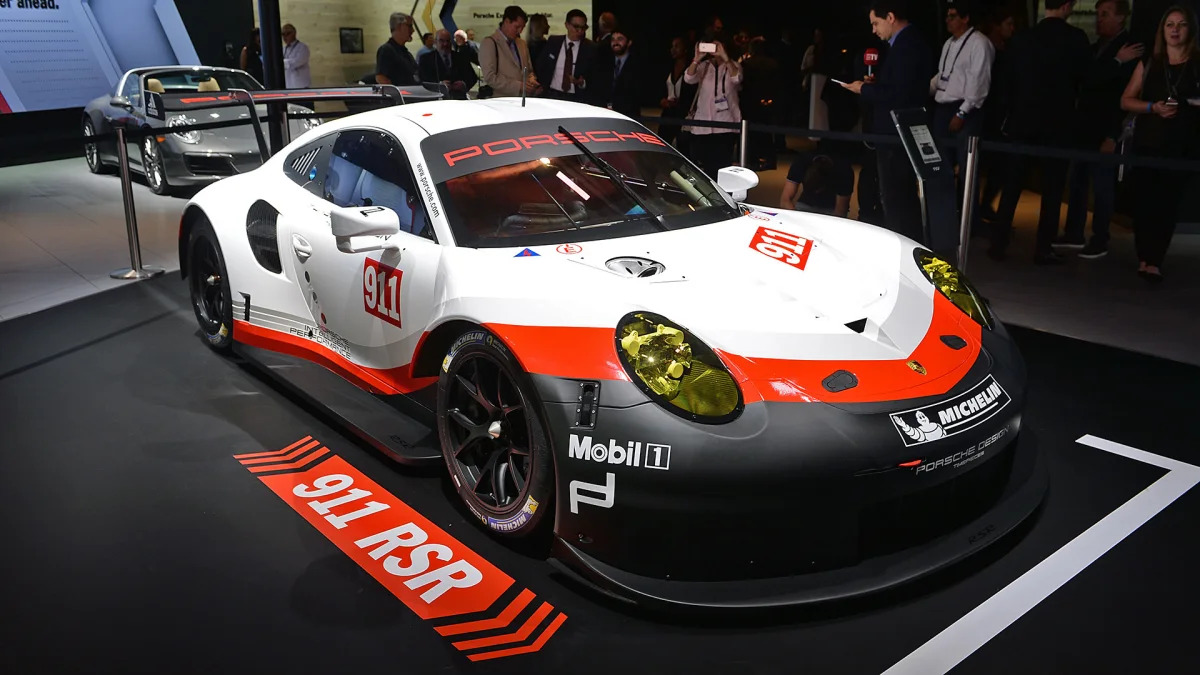Porsche unveiled its World Endurance Championship and IMSA WeatherTech Championship competitor with the 2017 911 RSR. And this 911 is different from the rest, as the 4.0-liter flat-six engine powering this beast is in front of the rear axle, not behind it. That's right, this 24 Hours of Le Mans competitor ditches the iconic rear-engine layout.
Porsche isn't talking specifics on how exactly things are arranged back there. The engine is new, now based on the 991 911's block instead of the previous Mezger motor that's been used for years. The transmission design is new as well – it would have to be to accommodate the new location relative to the engine.
The racecar has been engineered to meet the LM-GTE class, where it will go up against other mid-engine cars like the Ford GT and Ferrari 488 GTE. Moving the engine to the middle has given Porsche the ability to fit the 911 RSR with massive bits of aero, like the humongous rear diffuser that looks like it would be more at home on a machine of war. The only thing that can compete with the diffuser for size is the top-mounted rear wing, which shares a similar design to the one found on the 919 Hybrid.
Going back to the engine, the direct-injected boxer motor, depending on the size of the restrictor, generates as much as 510 horsepower and sends all of its fury to the rear wheels. The engine is paired to a six-speed sequential gearbox, which drivers can employ through paddles on the steering wheel. The new engine doesn't have a lot of weight to push around as the 911 RSR, as required by regulations, weighs 2,740 pounds.
Speaking of weight, the engine layout isn't the only change for the 911 RSR. For 2017, the car ditches its steel body for one that's made out of carbon fiber. The body attaches to the chassis via quick-release fasteners, making the vehicle easier to service as exterior elements can be removed with minimal effort. The racecar also gets a radar-based collision system – aptly named the "Collision Avoid System" – which is meant to limit the 911 RSR's encounters with faster LMP prototypes.
Only time will tell if the new layout and aerodynamic components help the 911 RSR beat its competition. But there will be plenty of opportunities to see the racecar in action as Porsche plans to run the 911 RSR in 19 races during the 2017 season, the first of which will take place at the IMSA opener on January 28th at Daytona, where the racecar will make its track day debut.
What does this mid-engine racer mean for future production 911 variants? We don't know, and Porsche certainly isn't saying. The RSR's rearrangement could preview a similar change for the new modular next-gen 911, which will share its platform with the mid-engine 718 Boxster and Cayman, or it could just be for competition. Either way, it seems like a quiet admission that there is something to that mid-engine layout after all.
Related Video:
Porsche isn't talking specifics on how exactly things are arranged back there. The engine is new, now based on the 991 911's block instead of the previous Mezger motor that's been used for years. The transmission design is new as well – it would have to be to accommodate the new location relative to the engine.
The racecar has been engineered to meet the LM-GTE class, where it will go up against other mid-engine cars like the Ford GT and Ferrari 488 GTE. Moving the engine to the middle has given Porsche the ability to fit the 911 RSR with massive bits of aero, like the humongous rear diffuser that looks like it would be more at home on a machine of war. The only thing that can compete with the diffuser for size is the top-mounted rear wing, which shares a similar design to the one found on the 919 Hybrid.
Going back to the engine, the direct-injected boxer motor, depending on the size of the restrictor, generates as much as 510 horsepower and sends all of its fury to the rear wheels. The engine is paired to a six-speed sequential gearbox, which drivers can employ through paddles on the steering wheel. The new engine doesn't have a lot of weight to push around as the 911 RSR, as required by regulations, weighs 2,740 pounds.
Speaking of weight, the engine layout isn't the only change for the 911 RSR. For 2017, the car ditches its steel body for one that's made out of carbon fiber. The body attaches to the chassis via quick-release fasteners, making the vehicle easier to service as exterior elements can be removed with minimal effort. The racecar also gets a radar-based collision system – aptly named the "Collision Avoid System" – which is meant to limit the 911 RSR's encounters with faster LMP prototypes.
Only time will tell if the new layout and aerodynamic components help the 911 RSR beat its competition. But there will be plenty of opportunities to see the racecar in action as Porsche plans to run the 911 RSR in 19 races during the 2017 season, the first of which will take place at the IMSA opener on January 28th at Daytona, where the racecar will make its track day debut.
What does this mid-engine racer mean for future production 911 variants? We don't know, and Porsche certainly isn't saying. The RSR's rearrangement could preview a similar change for the new modular next-gen 911, which will share its platform with the mid-engine 718 Boxster and Cayman, or it could just be for competition. Either way, it seems like a quiet admission that there is something to that mid-engine layout after all.
Related Video:


















Sign in to post
Please sign in to leave a comment.
Continue